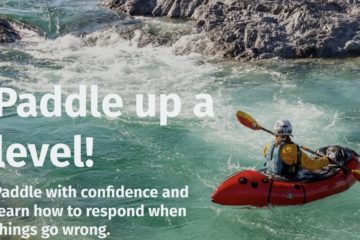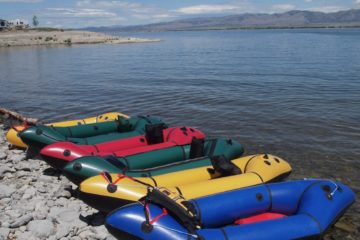Spring is here in the northern hemisphere and many of us are getting excited about packrafting trips we have planned for this paddling season, so now is a good time to think about paddling safety.
Packrafting fatalities are very rare – in most years since record-keeping began there have been zero packrafting-related deaths or just one – worldwide. That’s significantly fewer than deaths from lightning strikes, shark attacks, and selfie-taking. On one hand it’s a very good record, but on the other hand these packrafting-related deaths are avoidable, so even one per year is too many.
With packrafting’s increasing popularity it might seem inevitable that these numbers will rise, and in some recent years there have been a few more deaths than usual, but as paddlers we are not passive participants in some kind of morbid lottery – there are many things we can do to avoid ending up as one of those “unlucky” few (luck has little to do with it).
Three Ingredients for Safe Packrafting
Safe paddling requires equipment, skills, and judgment.
Equipment includes the obvious things like a packraft in good condition, a PFD, and a helmet if the conditions warrant it, but equipment also includes a long list of things like maps, first aid kits, phones or satellite messengers. Find out what is legally required equipment for paddling where you live and then add packraft-specific things to the list. When packing for a trip, always use a checklist to avoid forgetting something important. If you’d like to see my personal gear list for solo packrafting, I’ve posted it here. When paddling in a group, you’ll want to bring things like throw ropes and other rescue equipment that isn’t on my list.
Skills create the ability to use our equipment properly and proficiently -the best equipment in the world isn’t worth much if you don’t know how to use it. Nowadays there are many resources that can help you develop paddling/camping/navigating/hiking skills, and I recommend checking out Luc Mehl‘s website and his book The Packraft Handbook as a starting point. I don’t have any financial incentive to promote Luc’s work – I just think it’s great, and Luc has done a lot to create a packrafting culture of safety. I also recommend attending a swiftwater rescue course.
Judgment is the ability to assess a situation and determine the most appropriate course of action given the available skills and equipment. Adapting a famous quote to packrafting we can say, “A superior packrafter uses superior judgment to avoid situations which require the use of superior skill.”
We begin using our judgment in the earliest planning stages of a trip when we assess a route to determine whether or not our skills and equipment are sufficient to get us through safely in the available time. We continue using our judgment as we assess the weather, water conditions, what line to paddle, and whether the next challenge can be safely navigated or if we should divert around it. Even the best skills and equipment can’t compensate for poor judgment; when we exercise poor judgment, only luck can save us.
Good judgment is usually born from experience, but as social animals we can learn not just from our own experience, but from the experience of others. Join a paddling club or find a more experienced paddling partner and your judgment will improve quickly without having to rely on luck to get you up the learning curve alive.
When choosing paddling partners, avoid people who exhibit signs of the classic Hazardous Attitudes that tend to get people into trouble:
- Antiauthority: “You can’t tell me!”
- Impulsivity: “Quick, do something!”
- Invulnerability: “It won’t happen to me…”
- Macho: “I can do it – watch me.”
- Resignation: “What’s the use…?”
If you recognize any of these hazardous attitudes in yourself, find a paddling partner with the opposite personality trait who will be your voice of reason.
Judging our Judgment
Judgment also includes the ability to take an honest look at ourselves and our paddling partners and recognize when our skills or judgment may be impaired.
In the moment, a person’s ability to make good judgments is affected by several factors, and we can borrow an acronym from aviation that will help us perform a quick self-assessment before we paddle: I’M SAFE – which stands for
- Illness
- Medication
- Stress
- Alcohol
- Fatigue
- Emotion
Let’s take a quick look at each one.
Illness: Few of us would choose to set out on a paddling trip when we are feeling ill, but if we get sick in the backcountry (or hypothermic, or even hungry) our judgment will be impaired.
Medication: Many medications subtly affect our judgment, alertness, mood, ability to concentrate, and motor skills. Over-the-counter medications such as antihistamines, muscle relaxants, and even dietary supplements should not be underestimated – there are reasons why pilots are prohibited from using a long list of these things. Always read the packaging and, if in doubt, do some googling or consult a doctor before you mix medication and packrafting.
Stress: For most of us, a moderate amount of stress will focus our minds and help us perform at our highest level, but too much stress can cause us to make bad decisions. An example of increasing stress in packrafting is a weekend trip that is taking longer than expected: we start rushing because we feel the pressure of work or school coming up on Monday morning, and because of this perceived deadline we start making bad decisions, such as not scouting rapids or choosing to paddle bigger rapids than we normally would because we don’t want to “waste” time portaging around them. Pilots have a name for this condition – “get-home-itis” – and it has killed many, many people. Other stressors that can lead us to make bad decisions include inclement weather, running out of food, and impending darkness (to name a few). These are all things we can control or avoid by planning ahead and exercising good judgment in the first place. Also be aware that stress in other areas of life, such as work, school, family, and relationships can follow us into the backcountry, and physical stress such as hot or cold temperatures, pain, or an injury also take a mental toll. Extreme stress, such as dealing with an emergency, affects different people in different ways – it can paralyze us with indecision or short circuit our judgment, causing us to do the first thing that comes to mind.
Alcohol: I probably don’t need to remind you of the effects that alcohol has on judgment and motor skills. Alcohol and boats do not mix well, so save the drinks (or other drugs) until the end of the paddling day.
Fatigue: Fatigue has similar effects to alcohol, impairing both our motor skills and our judgment. Many of us don’t sleep well when we’re camping, so we might not perform well after a night in a tent. The effects of fatigue accumulate over multiple days of reduced sleep, so be aware that towards the end of a multi-day trip your brain and body might not be functioning as well as they did on day one. Even a day trip after a good night’s rest can end badly due to fatigue if our physical fitness isn’t up to the challenge.
Emotion: Extreme emotions are extremely distracting and they can put us in a reckless state of mind. It might seem like going for a paddle might be just the thing you need after a difficult day, but if you’re experiencing intrusive thoughts due to anger, grief, depression, or even euphoria, consider a less risky outlet instead.
By taking a moment to run through the I’M SAFE checklist we can make a meta-judgment about our present ability to make good judgments. Cool, huh?
That’s all for now, but if you have other tips for safe paddling, please leave a comment below!



2 Comments
Leo · May 29, 2023 at 11:24 pm
hi Matt I live in NZ and was wanting to take my Telkwa 130 out on some rapids. what sort of grades do you paddle in these boats and if you know of other people that paddle higher grades.
Matt (Admin) · May 30, 2023 at 8:56 am
Personally, I am only skilled enough for class 2 whitewater, but skilled paddlers have used DIY packrafts in class 4 rivers. More on this here: https://www.diypackraft.com/faq/whitewater-capabilities-of-diy-packrafts/